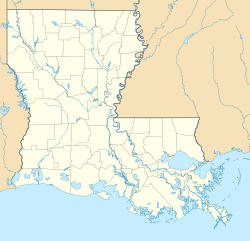Hickory Creek (Dobson Bayou tributary) facts for kids
Quick facts for kids Hickory Creek |
|
|---|---|
| Country | United States |
| State | Louisiana |
| Parish | St. Tammany Parish |
| Physical characteristics | |
| Main source | St. Tammany Parish, Louisiana, United States 30°38′41″N 89°39′34″W / 30.64472°N 89.65944°W |
| River mouth | St. Tammany Parish, Louisiana, United States 46 ft (14 m) 30°37′25″N 89°50′30″W / 30.62361°N 89.84167°W |
Hickory Creek is a small waterway located in St. Tammany Parish, Louisiana, in the United States. It is a tributary, which means it's a smaller stream or river that flows into a larger one. Hickory Creek flows into Dobson Bayou, which is another important waterway in the area.
Contents
What is a Creek?
A creek is a natural stream of water, usually smaller than a river. Creeks are often found in wooded areas or low-lying lands. They play a vital role in the environment.
How Creeks Form
Creeks often start from springs, rainwater, or groundwater that seeps out of the ground. They flow downhill, following the lowest path. As they flow, they can carve out small valleys.
The Role of Creeks
Creeks are like nature's highways for water. They help carry water from higher elevations to lower ones. This water eventually reaches larger rivers, lakes, or even the ocean. Creeks also help to keep the land moist.
Where is Hickory Creek Located?
Hickory Creek is found in the southeastern part of Louisiana. This area is known for its beautiful natural landscapes. It includes many forests, wetlands, and waterways.
St. Tammany Parish
St. Tammany Parish is a large area in Louisiana. It is located just north of Lake Pontchartrain. The parish has a mix of urban and rural areas. It is home to many different plants and animals.
Source and Mouth
Hickory Creek begins in St. Tammany Parish. Its starting point is called the "source." The creek then flows for some distance. It eventually reaches its "mouth," where it joins Dobson Bayou. Both its source and mouth are within St. Tammany Parish.
Life Around the Creek
Creeks like Hickory Creek are important habitats for many living things. They provide water, food, and shelter. The areas around creeks are often rich in biodiversity.
Plants and Trees
Along the banks of Hickory Creek, you might find many types of plants. These include various grasses, shrubs, and trees. Common trees in Louisiana can include bald cypress, water oak, and sweetgum. These plants help to stabilize the soil. They also provide shade, keeping the water cool.
Animals in and Near the Water
Many animals depend on creeks. Fish, frogs, and turtles live in the water. Insects like dragonflies and damselflies also thrive near creeks. Larger animals, such as raccoons, opossums, and various birds, visit the creek to drink water and find food.
Aquatic Life
Small fish species often live in creeks. They feed on tiny insects and plant matter. Frogs lay their eggs in the water. Their tadpoles grow up in the creek before becoming adult frogs. Turtles might bask on logs or rocks near the water's edge.
Land Animals
The trees and bushes along the creek provide homes for birds. You might see herons or egrets fishing in the shallow water. Mammals like deer might come to the creek for a drink. The creek ecosystem supports a wide range of wildlife.
Protecting Our Creeks
Creeks are valuable natural resources. It is important to protect them from pollution and damage. Healthy creeks mean a healthy environment for everyone.
Why Creeks Need Protection
Creeks can easily be polluted by trash, chemicals, or soil runoff. Pollution harms the plants and animals that live there. It can also affect the quality of water downstream. Protecting creeks helps keep our water clean.
How You Can Help
There are many ways to help protect creeks.
- Never throw trash into a creek or on its banks.
- Support efforts to clean up local waterways.
- Learn more about the plants and animals that live in your local creeks.
- Encourage others to be responsible stewards of nature.
By taking care of creeks like Hickory Creek, we help ensure that these important natural areas remain healthy for future generations.


